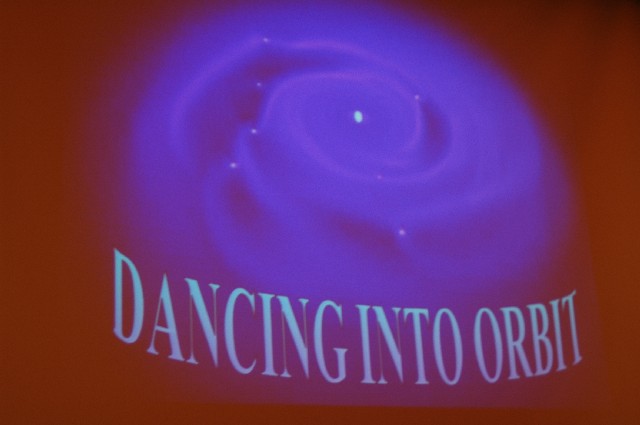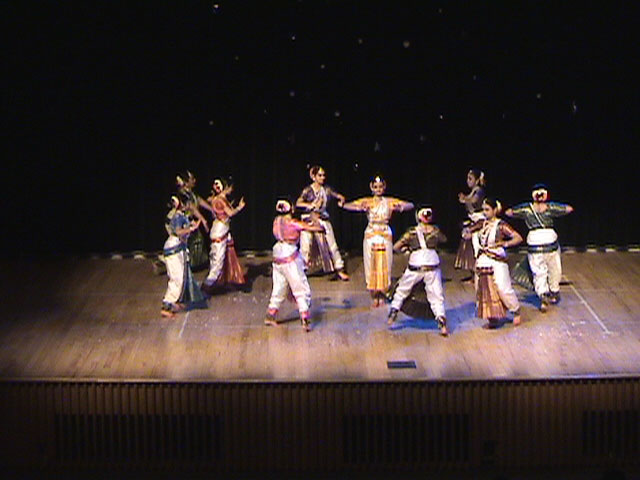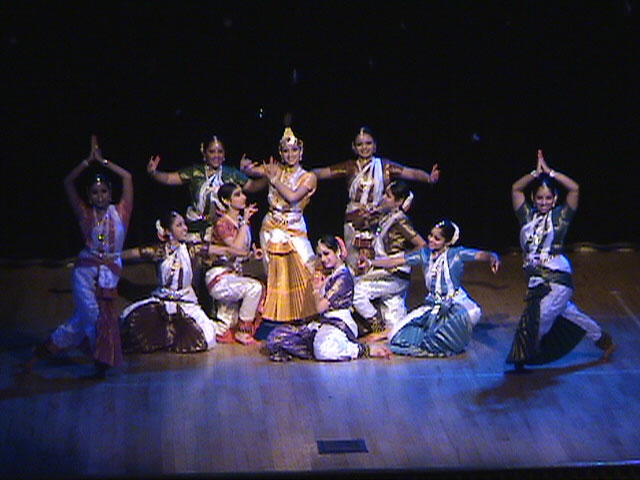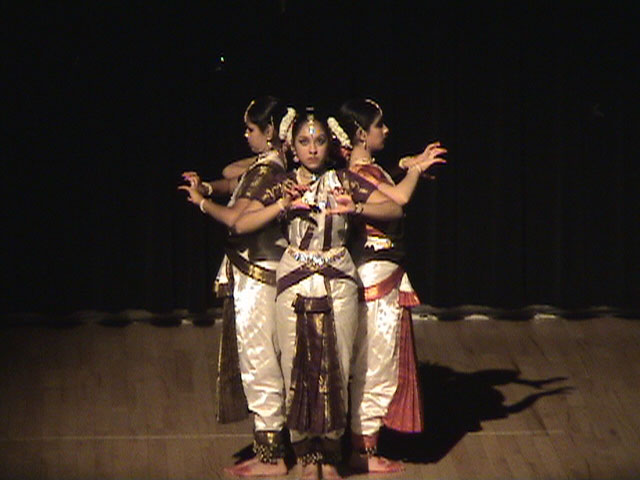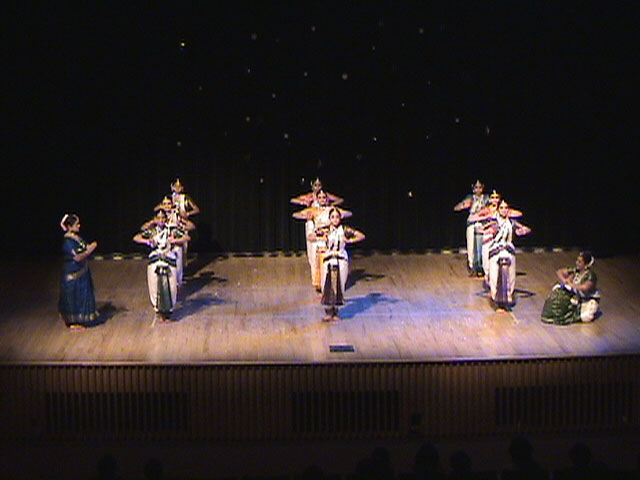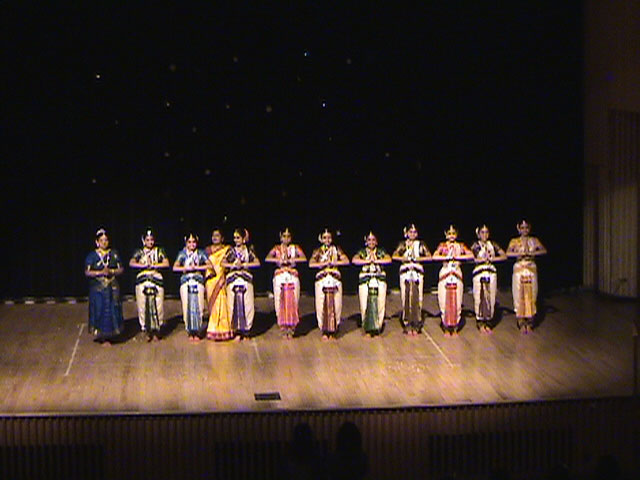Contribute
| Dancing Into Orbit - An Innovative And Invigorating Enterprise |
Chitra Parayath
08/11/2004
Boston area arts enthusiasts were treated to a spellbinding Bharathanatyam ballet, ‘Dancing into Orbit’ on Sunday, August 8 at the Cohen Auditorium, Tufts University in Medford, MA.
Conceived by Ms. Vasantha Vaikunth, the ballet was produced and executed by the students of local Dance teacher Ms. Ranjani Saigal and the reputed Bharathanatyam teacher from Chennai Ms. Kausalya Srinivasan.
As classical dance spewed forth in delightful abundance, soul-stirring music soothing one moment and soaring the next complemented the dance performance.
A spellbinding combination of sheer tempo, roaring drum rhythms, intricate foot movements showcased the expressional acumen of the dancers, the musicians, the choreographers and the entire production team.
‘Dancing into Orbit’, the program sheet read ‘is a dramatic interpretation of the stories of the nine grahas (planets) and their influence on the lives of people.’ It further went on to state that ‘It is based on the Hindu astrological system of nine grahas, or celestial bodies, that control the fate of every being.
The dance explores form, movement, space, and time as evoked by the nine planets, the 'Navagrahas’.In the opening scene Srishti ( Creation of the Species and the Planets), Nature blends in harmony to suit all species. The qualities of all the nine planets are revealed and the way they align themselves. The devotees sing in praise of each planet and the scene ends with Salutations to the Sun God ( Suryanamaskaras)’
The ballet began with an introduction to each of the grahas, and their particular properties. We were then introduced to an anthropomorphic personification of Time, the kala purusha, the narrator who explained that every person has a purpose in the cosmic drama of life, and that this purpose is created and carried out through the influences of the grahas. This clever touch lent the drama a timeless quality, with scenes blending and interpreting the past and present with artistic grace.
The rest of the ballet comprised of examples from Indian mythology that demonstrated the effects that the grahas had on the lives of well-known characters. The first depicted the divine love of Radha and Krishna and the gopikas who had an intense and endless sensual love for Krishna. This was caused by the combined effects of Chandra (Moon) and Sukran.( Venus)
The second tale was that of was Buddha, who was influenced by Rahu to leave his comfortable life as a prince to go out in search of truth, and also by Ketu who ultimately helped him attain enlightenment. The third depicted protagonist was Ashoka whom Kuja, (Mars), lead to war, and violence. Guru, (Jupiter), invokes feelings of remorse and guilt in Ashoka, leading him to Buddha who finally teaches him how to achieve peace within himself.
The final scene of the ballet portrayed the present, and the influences of Surya, (the Sun), who brings knowledge and Shani, (Saturn), who leads humanity to salvation through suffering. The ballet concluded with a mangalam, the traditional prayer at the end that gives thanks.
The dancers’ unbelievable grace and tremendous energy kept the breathless drive for the entire ballet and left the audience wanting for nothing. The feast of classical movement interspersed with thoughtful narration and slides explaining the various sections provided an epic quality to the production.
Ranjani Saigal, Kausalya Srinivasan and Vasantha Vaikunth could be credited with opening this dance language for meaningful interpretations and giving the ballet a cosmic charm. Precision and exactness cloaked the final scene that depicted how spirituality could help overcome stress and strife and that meaningful denouement prompted the audience to give the team a standing ovation.
Said Ms.Vasantha Vaikunth, who traveled from Muscat to be part of the production; “ It has been a very satisfying experience for me. The girls have all put their soul into the performance and it shows. It was an experimental symbolic theater experience. The spiritual angle of the production appealed to me.
Kausalya Srinivasan said “ It is amazing what the whole team brought forth to the fore. The girls gave everything to the whole production and were a delight to work with. It has been a true collaborative effort, with the dancers doubling as co- choreographers. It has been a learning experience for me also to be able to work with such a talented and dedicated team.”
Ranjani Saigal said "It was a very unusual and challenging experience. We had work on the unusual theme of the life of Buddha and Ashoka - not a common Bharatanatyam motif. Researching the story and creating the story board was an interesting experience. All the students made significant contribution to the choreography and as a teacher that was very exciting for me. Even the backdrop was created by them.
As a technologist I was excited to get the opportunity to use complex lighting and multimedia presentations. I think the whole production took Bharatanatyam to another dimension”
Credits
Concept and Creation – Vasantha Vaikunth
Production Team (Training, Choreography, Lighting, Costumes, Multimedia) - Kausalya Srinivasan and Ranjani Saigal.
Lyrics – Dr. Pappu Venugopal Rao
Music - Rajesh Vaidya and Hariprasad
Vocal- Hariparasad
Nattuvangam – Kausalya Srinivasan
Chendai, Kunnakol – Keshavan
Mridangam – Vijayaraghavan
Veena- Rajesh Vaidya
Flute – Bangalore Ravi
Keyboard – Solomon
Tabla – Raghu
Dancers
Amrita Saigal
Komal Patel
Manaswini Garimella
Megan Jayaraj
Sachi Phene
Shannon Stanton
Sneha Durgapal
Somiya Kalloo
Vinisha Patel
Vishnupriya Samudrala
You may also access this article through our web-site http://www.lokvani.com/
